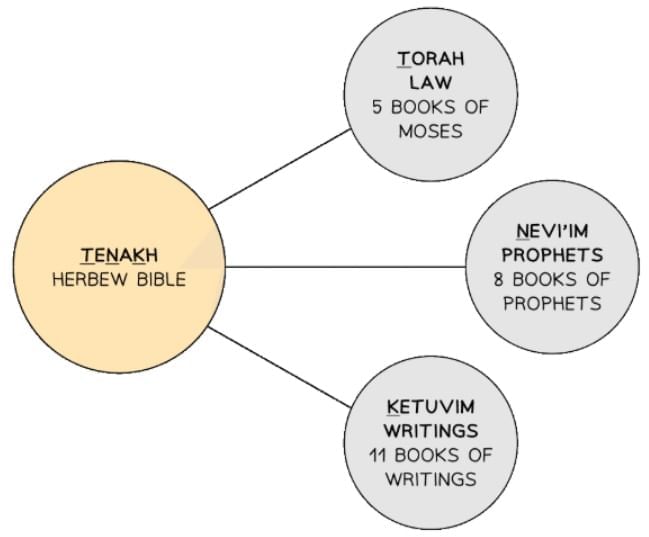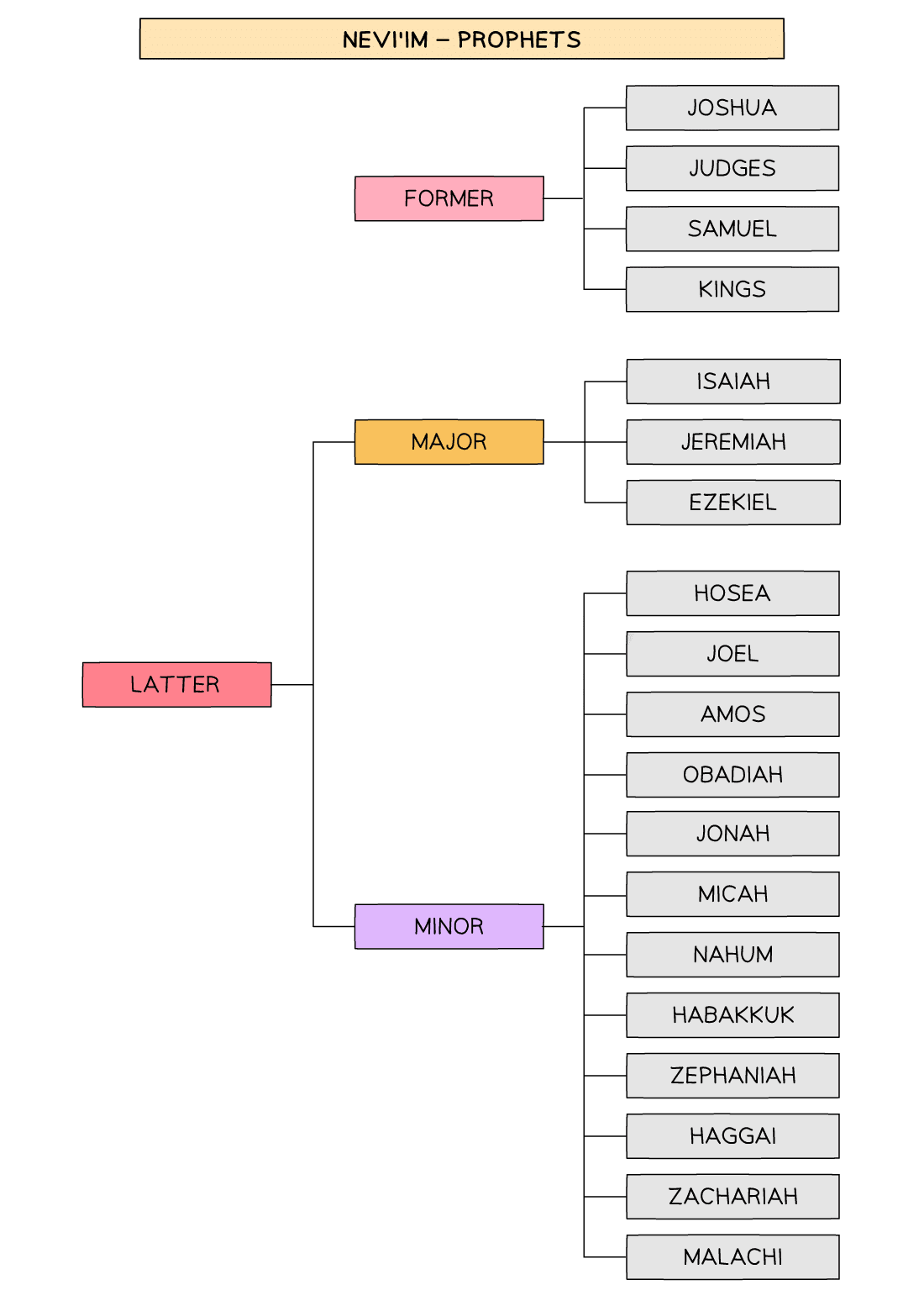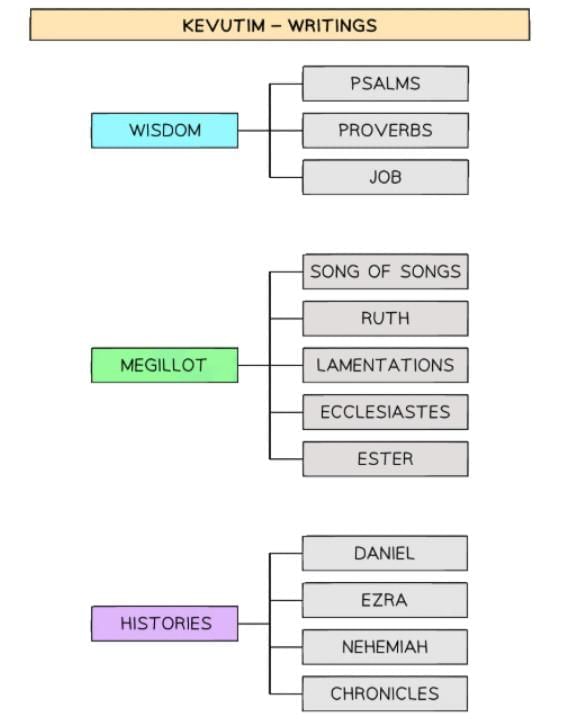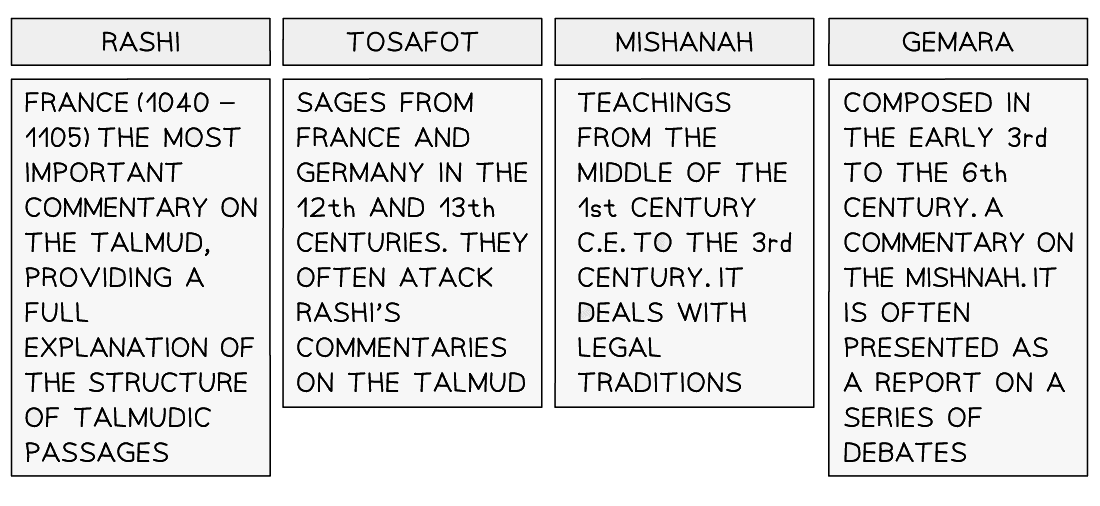The Tenakh & the Talmud | Religion, Philosophy & Ethics for GCSE/IGCSE - Year 11 PDF Download
| Table of contents |

|
| The Study of Tenakh |

|
| The Torah |

|
| Nevi'im (Prophets) |

|
| Ketuvim (Writings) |

|
| The Study of Talmud |

|
| The Use & Significance of the Talmud |

|
The Study of Tenakh
The Tenakh, the primary sacred text of Judaism, governs all facets of Jewish life. It corresponds to the Old Testament in the Christian Bible, though arranged differently. Often written as TeNaKh, it comprises three sections: Torah, Nevi’im, and Ketuvim.
The Torah
The Torah encompasses the foundational laws and teachings of Judaism, consisting of the first five books of the Old Testament:
- Genesis
- Exodus
- Leviticus
- Numbers
- Deuteronomy
Given to Moses by God, the Torah includes the mitzvot, notably the Ten Commandments.
It holds immense reverence in Judaism:
- Reading from it during synagogue services is an honor.
- Touching the Torah with bare hands is prohibited; a pointer called a yad is used instead.
- In Orthodox synagogues, the Torah is read aloud over one year; in Reform synagogues, over three years.
- Congregants bow as the Torah is carried through the synagogue.

Nevi'im (Prophets)
The Nevi'im consists of eight books tracing Jewish history and elaborating on the laws. Named after eight prophets chosen by God to guide Jews in following His laws, it is divided into two sections:
- Former Prophets: These detail the history of the Israelites.
- Latter Prophets: These include the words of 15 prophets, such as Isaiah, often in poetic form.

Ketuvim (Writings)
The Ketuvim comprises 11 books, including Psalms and Proverbs, many of which explore philosophical themes.
The Use & Significance of Tenakh
The Tenakh, written in Hebrew, includes the Torah, prophetic teachings, and sacred writings, serving as the cornerstone of Jewish life:
- It contains the Ten Commandments, given to Moses on Mount Sinai, guiding Jews in showing love for God and neighbors.
- It includes all 613 mitzvot, which are obligatory or prohibited actions for Jews.
- The Torah within the Tenakh is the written law.
- It records the detailed history of the Jewish people, including figures like Abraham and Moses.
- Jews study the Tenakh extensively to deepen their relationship with God.
The Use and Significance of Torah
The Torah is the holiest part of the Tenakh, believed to be God’s direct word given to Moses on Mount Sinai. While all Jews use it as a guide, interpretations vary:
- Orthodox Jews strictly adhere to all Torah rules.
- Reform Jews prioritize rules they deem relevant, disregarding those seen as outdated.
The Torah’s significance is reflected in its use:
- It is read weekly in synagogues, completing a cycle in one year.
- The festival of Shavuot celebrates God’s revelation of the Torah to Moses.
- Its commandments shape contemporary Jewish life.
The Use and Significance of Nevi'im
The Nevi'im, the second section of the Tenakh, follows the Torah and precedes the Ketuvim. It is divided into:
- Former Prophets (Nevi'im Rishonim): Includes Joshua through Kings, focusing on Israelite history.
- Latter Prophets (Nevi'im Aharonim): Contains prophetic messages, often in poetic form.
These books chronicle Jewish history after Moses, illustrating the covenant relationship with God. The Haftarah, a selection from the Nevi'im, is read publicly in synagogues after the Torah on Sabbaths, festivals, and fasting days.
The Use and Significance of Ketuvim
The Ketuvim, the final section of the Tenakh, follows the Torah and Nevi'im. It records Jewish history and actions within the covenant relationship with God. Its books cover diverse themes:
- The Book of Job explores a righteous man’s trials by God, teaching that suffering is not always due to sin.
- Psalms is a collection of writings praising God.
The Study of Talmud
The Talmud
While the Torah is eternal, some Jews seek new interpretations to apply its teachings to modern life. The Talmud aids this by interpreting Torah laws for contemporary issues. It comprises two parts:
- Mishnah: Compiled by Rabbi Judah Ha’Nasi, it records the oral law to prevent misinterpretation, explaining how to apply the mitzvot. It includes first-century rabbinic discussions on adapting Torah laws to new contexts.
- Gemara: A collection of discussions and comments on the Mishnah.
There are two versions of the Talmud: the Jerusalem Talmud and the Babylonian Talmud, differing in origin, compilation date, and content.
Differences between Jerusalem and Babylonian Talmuds
- Jerusalem Talmud:
- Shorter, more focused, with a looser structure.
- Less authoritative than the Babylonian Talmud.
- Records opinions mainly from Israeli rabbis, rarely Babylonian ones.
- Covers fewer generations due to earlier completion.
- Babylonian Talmud:
- Longer, with a uniform style indicating editorial refinement.
- Holds greater authority within Judaism.
- Includes opinions from both Israeli and Babylonian rabbis.
- Covers more generations due to later completion.
Studying the Talmud
The Torah and Talmud are central to Jewish teachings, forming the basis of laws and customs. Studying the Talmud helps Jews explore key issues and values, contributing to nearly two millennia of Jewish legal discourse.
The Use & Significance of the Talmud
The Significance of the Talmud
The Talmud contains rabbinic teachings that interpret and expand Torah law for daily life in the first five centuries CE. For many Jews, it is as holy and binding as the Torah. Known as the Oral Torah, it is believed to have been given to Moses by God alongside the Written Torah, passed down orally until recorded in the Talmud. The Talmud, comprising the Mishnah and Gemara, provides detailed commentary on the Mishnah.
The Use of the Talmud
The Talmud elaborates on how to implement Torah commandments:
- For example, while the Torah prohibits work on the Sabbath, the Talmud’s tractate Shabbat defines work and its permissible categories.
- It addresses modern issues like genetic engineering, euthanasia, contraception, and the sanctity of life.
- The Talmud is studied in yeshivot, synagogues during kollel, between prayers, or at home.
- It covers essential Jewish topics, including Shabbat, Laws of Niddah, Laws of Yom Tov, blessings, and fasts, providing both meaning and practical guidance for Jews today.
|
172 docs|3 tests
|
FAQs on The Tenakh & the Talmud - Religion, Philosophy & Ethics for GCSE/IGCSE - Year 11
| 1. What is the significance of the Torah within the Tenakh? |  |
| 2. How do the Nevi'im contribute to the understanding of Jewish history and prophecy? |  |
| 3. What role do the Ketuvim play in the literary and theological aspects of the Tenakh? |  |
| 4. How does the Talmud relate to the study of the Tenakh? |  |
| 5. Why is the study of Tenakh essential for understanding Jewish identity and culture? |  |














